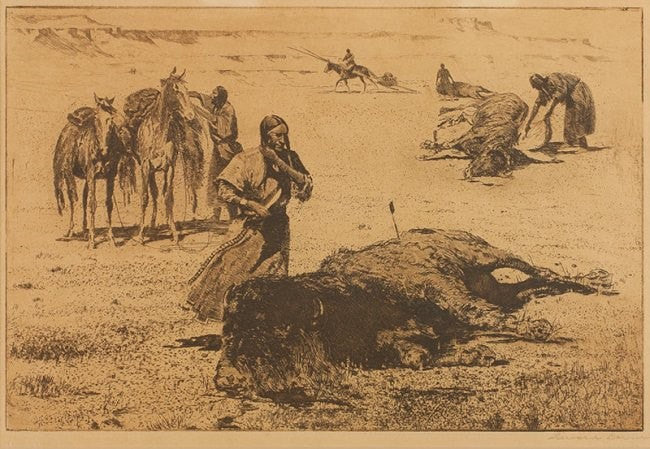
Western Art : Edward Borein, Cowboy Artist, "After the Buffalo Hunt", Western Artist, #336
$ 10,000.00
Western Art
336. Description: Edward Borein, 1872 - 1945 | Signed: Edward Borein [in margin], l/r | Media: Etching and drypoint |
Dimensions: 8 by 12 inches.
Condition: Excellent for its age.
Provenance: Ex Altermann Galleries and Auctioneers.
------------
Additional Edward Brien Etchings can be found at:https://www.etsy.com/your/shops/CulturalPatina/sections/16492699
---------
Born in San Leandro, California, Edward Borein became one of the most popular artists of western scene painting, equally adept at ink drawing, watercolor, and etching.
He was raised in San Leandro, a western cow town, in a family where his father was a county politician. Edward had many childhood memories of herded cattle and their cowboys, which he began sketching at the age of five. He was educated in the Oakland, California schools, and at the age of 17 began working on a ranch near Oakland and then drifted and sketched as a working cowboy throughout the Southwest, Mexico, and Guatemala.
It was said that he practiced his art on anything he could find from bunkhouse walls to scraps of paper. At age 19, he enrolled at the San Francisco Art School, his only formal art training, and there he met Jimmy Swinnerton and Maynard Dixon who encouraged him in his art career.
The first person to purchase his work was Charles Lummis, editor of The Land and Sunshine magazine in California, and the two became life-long friends. Borein and Lucille Maxwell were married in the Lummis home. Borein, a typical westerner in dress and manner, also became close friends with Charles Russell, actor Will Rogers, and President Theodore Roosevelt. Borein often traveled north to visit Russell in Great Falls, Montana and to travel among Indian tribes.
In 1899, Borein visited Arizona while returning from Mexico. By 1902, he was a successful illustrator in San Francisco for the San Francisco Call, and in 1907 to enhance his illustration skills, went to New York to learn etching techniques. There he enrolled in the Art Students League and was a student of Child Hassam. In the theatre district, he opened a studio that became a gathering place for 'lonesome' westerners such as Charles Russell, Will Rogers, Olaf Seltzer and Oscar Borg. But Borein did not feel at home in New York, so he moved to Santa Barbara, California in 1921.
This was a final move. He and his wife built a Hopi-style home, and he taught at the Santa Barbara School of the Arts until his death, and also turned increasingly from oil to watercolor painting. "On occasion Borein would decorate place cards for dinners with small watercolor sketches of cowboys, vaqueros, Indians and Bucking horses". (Santa Fe Auction) From his studio, which again attracted many of his friends, he depicted Indians, cowboys, and California ranch life and was financially successful.
Source:
Edan Hughes, Artists in California, 1786-1940
Michael David Zellman, 300 Years of American Art
Santa Fe Art Auction catalogue, 10/2001
Note:
Edward Borein's birth date is often given as 1873. That date appears in many publications, however, I think now it is generally believed that the correct date is 1872. Harold Davidson uses the 1872 date, based on a birth notice in a California paper.
Sarah E. Boehme
The John S. Bugas Curator
Whitney Gallery of Western Art
Buffalo Bill Historical Center
-----------------
View the other items in my shop: http://www.etsy.com/shop/CulturalPatina?ref=shopsection_shophome_leftnav




